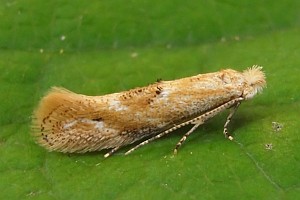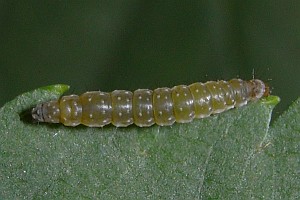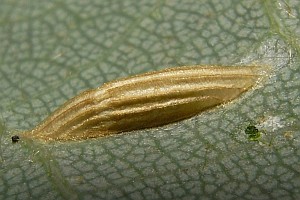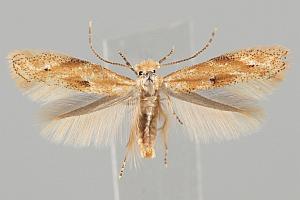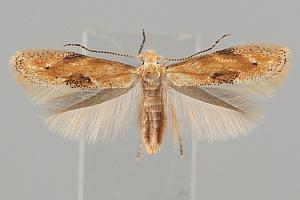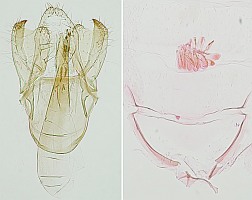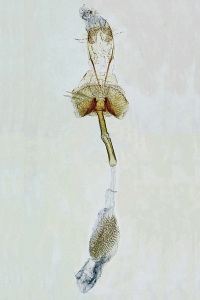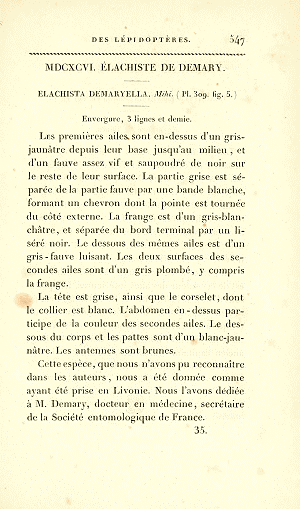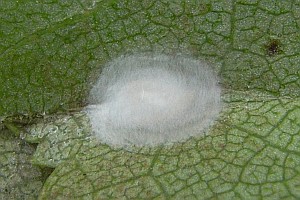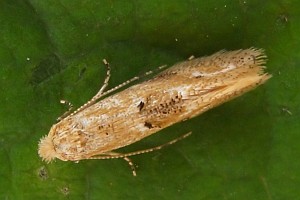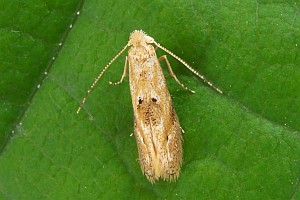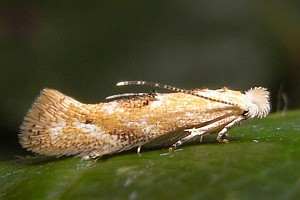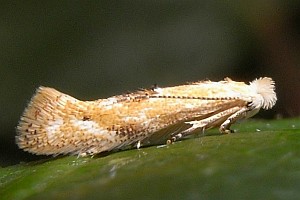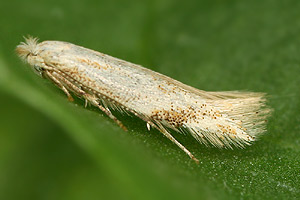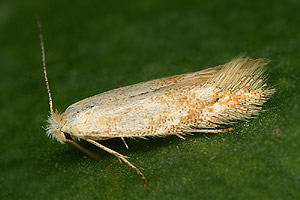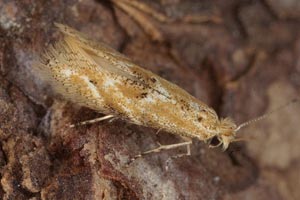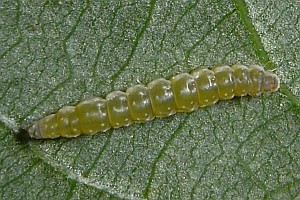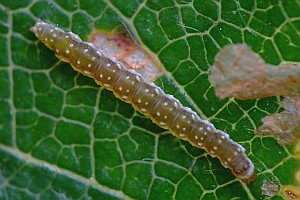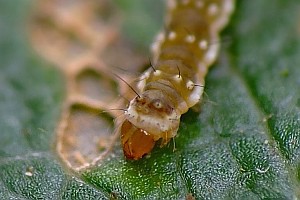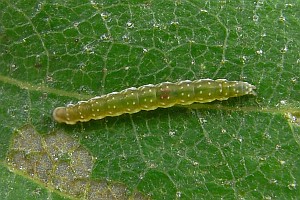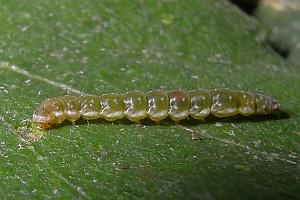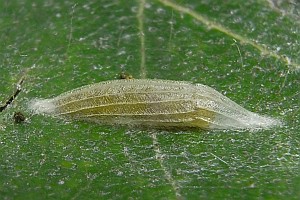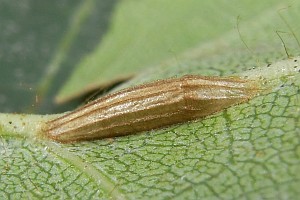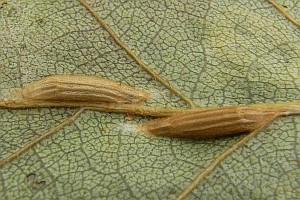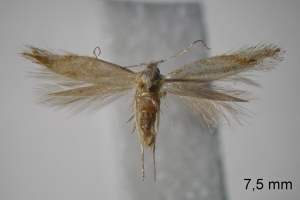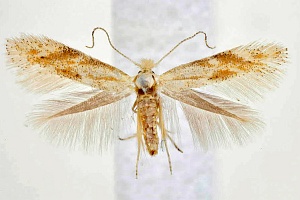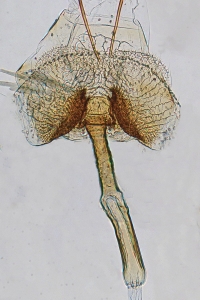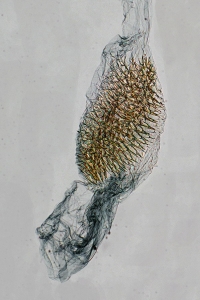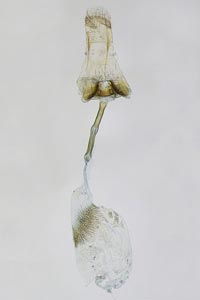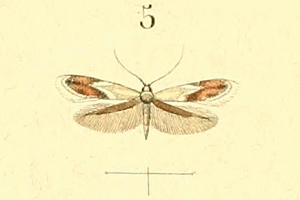

 +27Kontinente:EUAS
+27Kontinente:EUAS1. Lebendfotos
1.1. Falter
1.2. Raupe
1.3. Puppe
2. Diagnose
2.1. Männchen
2.2. Weibchen
2.3. Genitalien
2.3.1. Männchen
2.3.2. Weibchen
2.4. Mine
Lödl et al. (2014: 57-59) bilden Minen aus dem Herbarium von Hering ab.
2.5. Erstbeschreibung
3. Biologie
3.1. Lebensweise
3.2. Nahrung der Raupe
- [Betulaceae:] Betula pendula (Hänge-Birke)
- [Betulaceae:] Betula pubescens (Moor-Birke)
- [Betulaceae:] Corylus avellana (Haselnuss)
- [Fagaceae:] Castanea sativa (Edelkastanie)
- [Malvaceae:] Tilia cordata (Winter-Linde)
- [Sapindaceae:] Acer sp. (Ahorn)
- [Sapindaceae:] Aesculus hippocastanum (Rosskastanie)
Nach Patočka (1996) lebt die Raupe an Betula, Corylus, Acer sowie auch an Castanea sativa und Aesculus hippocastanum.
Die oben dokumentierten Raupenfunde in Nordwestsachsen beweisen, dass Linde (Tilia) eine weitere Nahrungspflanze ist. Am selben Fundort wurden auch Raupen an Betula pendula nachgewiesen.
4. Weitere Informationen
4.1. Etymologie (Namenserklärung)
Die Art wurde vermutlich nach dem Sammler (und auch Finder?) des Belegtiers genannt, jedenfalls nach einem wichtigen Kollegen: "Cette espèce [...] nous a été donnée comme ayant été prise en Livonie. Nous l'avons dédiée à M. Demary, docteur en médicine, secrétaire de la Société entomologique de France."
4.2. Andere Kombinationen
- Elachista demaryella Duponchel, [1840] [Originalkombination]
4.3. Faunistik
"Cette espèce [...] nous a été donnée comme ayant été prise en Livonie." Typenfundort - wenn auch mit großer Vorsicht formuliert, ist also Livland, ein Teil des Baltikums, das heute Estland und Lettland umfasst. Und tatsächlich ist die Art im Baltikum und anderen nordeuropäischen Ländern - aber auch im gesamten Mittel- und Westeuropa - weit verbreitet.
Laštůvka, A. & Z. Laštůvka (2014) melden die Art als neu für Spanien und erläutern: "ES: Orense, Sandiás, mines on Betula pubescens, 13-VI-2014. PT: Trás-os-Montes, PN Montesinho, Montesinho, 16-VI-2014, São Julião de Montenegro, mines on Betula pubescens, 18-VI-2014. European (Eurosiberian?) species, widely distributed especially in northern parts of Europe (MEY, 2013), larva mines on Betula spp., also Corylus and Castanea are known as host plants (e.g. HEATH & EMMET, 1985). In the Iberian Peninsula recorded in Beira Alta in Portugal (CORLEY et al., 2009). New species for Spain (Fig. 7, 8)."
(Autor: Erwin Rennwald)
4.4. Publikationsjahr der Erstbeschreibung
Woodward (1922: 379) [Digitalisat auf biodiversitylibrary.org] teilt die Publikationsjahre des Bandes mit: 1-240 (mit ?) und pl. 287-296 1838, 241-432 (mit ?) und pl. 297-302 1939, 433-720 (mit ?) und pl. 303-314 1840.
(Autor: Jürgen Rodeland)
4.5. Literatur
- Erstbeschreibung: Duponchel, P.-A.-J. (1838-[1840]): Histoire naturelle des lépidoptères ou papillons de France. Tome onzième: 1-720, pl. CCLXXXVII-CCCXIV. Paris (Méquignon-Marvis).
- Laštůvka, A. & Z. Laštůvka (2014): New records of mining moths from the Iberian Peninsula from 2014 (Insecta: Lepidoptera). — SHILAP Revista de Lepidopterología, 42 (168): 633-647. [PDF auf redalyc.org]
- Lödl, M., Gaal-Haszler, S. & S. Jovanovic-Kruspel (2014): Illustrated Catalogue of Hering’s herbarium of leafminers at the Natural History Museum Vienna, part 2 (plant families B-E). — Quadrifina 11: 1-219. [PDF auf zobodat.at, ca. 200 MB]
- Patočka, J. (1996): Die Puppen der mitteleuropäischen Bucculatricidae (Lepidoptera: Tineoidea). Dtsch. Ent. Z. 43: 281-306.
- Stainton, H. T. (1862): The natural history of the Tineina 7: I-IX, 1-251, Bucculatrix pl. I-IV, Nepticula pl. VIII-XI. London (John van Voorst) – Paris (Deyrolle) – Berlin (E. S. Mittler und Sohn). — Digitalisat auf archive.org: [80-87], [Bucculatrix pl. II fig. 3].
- Stark, W. (2020): Neunachweise von Lepidoptera (Schmetterlinge) für Österreich und Niederösterreich – Motivation zur Initiative „Leuchtturmprojekt Schmetterlinge Niederösterreich“ – Naturkundliche Mitteilungen aus den Landessammlungen Niederösterreich – 29: 19-28. [PDF auf zobodat.at]
- Woodward, B. B. (1922): Catalogue of the Books, Manuscripts, Maps and Drawings in the British Museum (Natural History). Vol. VI. Supplement: A–I: i-iv, 1-511, 1-48. London.


























